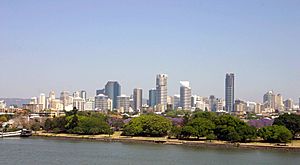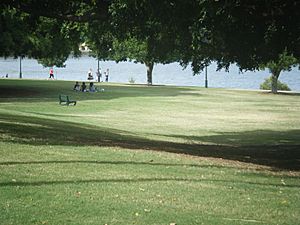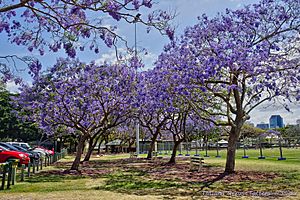New Farm Park facts for kids
Quick facts for kids New Farm Park |
|
|---|---|
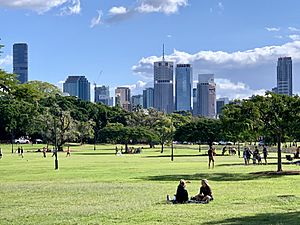
New Farm Park looking towards the Brisbane central business district
|
|
| Location | 137 Sydney Street, New Farm, City of Brisbane, Queensland, Australia |
| Design period | 1900-1914 Early 20th century |
| Built | 1914–1950,1915,1950,1955 |
| Architect | Albert Herbert Foster |
| Official name: New Farm Park | |
| Type | state heritage |
| Designated | 7 February 2005 |
| Reference no. | 602402 |
| Type | Recreation and entertainment: Picnic ground/recreation reserve |
| Theme | Building settlements, towns, cities and dwellings: Planning and form of settlements; Creating social and cultural institutions: Sport and recreation |
| Builders | Gladwin Legge & Co. |
| Lua error in Module:Location_map at line 420: attempt to index field 'wikibase' (a nil value). | |
New Farm Park is a beautiful park right by the river in New Farm, Brisbane. It's a special place with a long history, designed by Albert Herbert Foster. The park was built between 1914 and 1950. It's so important that it was added to the Queensland Heritage Register in 2005.
This huge park covers about 15 hectares (that's like 37 football fields!). It sits on a bend in the Brisbane River. You'll find the Brisbane Powerhouse arts centre right next to it. The park also has the New Farm Park ferry wharf, making it easy to get to by boat. It's one of Brisbane's most loved parks and a popular spot for both locals and tourists.
Contents
A Journey Through Time: New Farm Park's History
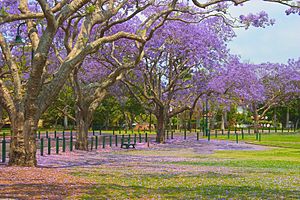
New Farm Park was officially created in 1914. Before Europeans arrived, this area was covered in natural bushland and had small lagoons. It was a rich source of food and resources for the local Aboriginal people, who called it Binkin-ba, meaning "place of the land tortoise."
From Farm to Racecourse
In the early days, after Brisbane was settled, the land where the park now stands was used as a farm. Convicts grew crops like maize and potatoes here. Later, in 1846, a horse racecourse was built on the site. This racecourse was a popular spot for races until 1913.
The land was then bought by the Brisbane City Council to create a public park. The official opening was delayed until July 1919 because of World War I. The Governor of Queensland at the time, Hamilton Goold-Adams, opened the park.
Designing a Green Space
Work on New Farm Park began in May 1914. Henry Moore, the City Parks Superintendent, led the design. He planned a long main drive, over 900 metres long, with wide pedestrian paths. Two lagoons with islands were dug, and earth was moved to fill in swampy areas.
Moore also designed beautiful gardens. He planned an ornamental flower garden and 14 large circular flower beds. Over 650 trees and plants were put in. More than 100 jacaranda trees were planted along the main drive. Poinciana trees were planted along Brunswick Street.
Early Park Features
In 1915, a kiosk (a small shop) and a bandstand were built. These were designed by Albert Herbert Foster, the City Architect. The kiosk was a lovely timber building with a tiled roof. It was located near the tennis courts and croquet lawns. The bandstand was a round building, perfect for concerts.
Other facilities added included croquet lawns, picnic spots, cricket wickets, tennis courts, and football grounds. In 1919, at the park's opening, it was noted that 800 rose bushes had been planted. Fig trees and Chinese elms were also planted along the park's edges.
Changes Over Time
In 1920, Edward, the Prince of Wales, visited the park. The Bougainvillea Avenue was then renamed "Prince's Walk." The park also received two war trophies in 1922: a German Howitzer gun and an Albatross aircraft. These were later removed.
The small creek that used to be the park's boundary was filled in over time. When the Brisbane Tramway Powerhouse (now the Brisbane Powerhouse arts centre) was built in 1927-1928, it set the park's current boundary.
In 1935, the main drive was paved to reduce dust. A proper cricket oval was created in 1938, along with dressing sheds. Basketball courts were built near the tennis courts. By 1940, the park was said to have 20,000 rose bushes!
Harry Oakman's Redesign
After 1948, Harry Oakman, a famous landscape architect, redesigned parts of the park. He added new paths and lookouts over the rose gardens. He also planted new trees and shrubs, while keeping many of the original ones.
Oakman's biggest change was his new layout for the rose gardens. He wanted the roses to be organized by type and colour. By 1957, there were over 10,000 rose bushes in the park! Some sources even claim 40,000 roses by 1965, making it one of Australia's top rose gardens.
After the 1974 Brisbane flood, which covered the rose beds in mud, thousands of new rose bushes had to be planted. A library was also built in the park in 1975.
What You Can See and Do Today
New Farm Park still has much of its original design from the early 1900s. You can also see parts of Harry Oakman's redesign from the 1940s and 1950s. Many of the old trees are still there, making the park feel grand and established.
Park Features and Facilities
The park is filled with many different types of trees, including jacarandas, poincianas, figs, and palms. There's a central lawn area and a rainforest section behind the library. You'll also find tropical plants growing under the shade of the trees.
You can enter the park by car at the Oxlade Drive entrance or the Library carpark. There are also many paths for people walking, including ones from Dixon Street and Brunswick Street. The beautiful jacaranda drive still follows its original path.
The park has lots of facilities for everyone:
- A large sports oval for games.
- A fun playground surrounded by huge banyan trees.
- Picnic and barbeque areas right by the river.
- A croquet lawn and two tennis courts.
- A library.
- A half basketball court.
- A canoe and boat ramp on the river.
Other buildings include toilets, shade shelters, a croquet clubroom, and a gardener's depot. The old bandstand, built in 1915, is still there and looks amazing with its tiled roof. You might also spot some sculptures and the Sandakan Memorial. A new ferry terminal makes it easy to arrive by boat.
Historical Highlights
Look out for these historical features:
- The remaining croquet lawn.
- The concrete stairway near the river, built around 1915.
- The sports oval.
- The jacaranda drive, which is stunning when the trees are in bloom.
- The beautiful Federation Queen Anne style bandstand.
You can also see parts of Oakman's rose garden design, the croquet clubhouse, and an old shed that was once an open picnic shelter. The soccer clubroom has a cool mosaic mural on its side.
The park is home to many old and impressive trees. These include the jacarandas and fig trees along the loop drive, weeping figs near the river, and banyan figs in the playground. There are also Queensland bottle trees and poincianas.
Events and Transport
New Farm Park is a popular spot for events. For many years, it was the finish line for the "Bridge to Brisbane" race. It also hosts the Queensland Pride fair day.
Getting to the Park
It's easy to get to New Farm Park!
- By CityCat ferry: Get off at the New Farm Park ferry wharf.
- By bus: Buses run along Brunswick Street.
- By car: There's parking inside the park and on nearby streets.
Why New Farm Park is Special
New Farm Park is listed on the Queensland Heritage Register for many reasons:
A Glimpse into History
The park shows how land use in Queensland has changed over time. It went from an Aboriginal resource to a farm, then a racecourse, and finally a public park. The Brisbane City Council bought the land because they were interested in making cities beautiful with parks. The park's redesigns also show how ideas about parks have changed, from formal gardens to places for barbecues and jogging.
Unique and Important
The 1915 bandstand is a rare and special building. The park itself is also unique because it was a completely new park designed by Henry Moore, unlike his other projects which involved redeveloping existing parks. The remaining croquet lawn is also uncommon.
Beautiful Design
The park is known for its beautiful views, the stunning jacaranda drive, and its river frontage. The rose gardens, tropical plants, and mature trees like palms, figs, and poincianas make it a lovely place to visit. People really appreciate its established subtropical garden feel.
Creative Achievements
Henry Moore, the first City Parks Superintendent, showed great creativity in his original design for New Farm Park. The jacaranda drive is still impressive today. Harry Oakman also showed creativity in his redesign of the rose gardens after 1948. Both men were pioneers in designing tropical gardens.
A Community Hub
The park has a strong connection with the local community. It's very popular with families, especially the playground. Many different groups use the park, including people for festivals, weddings, sports, and picnics.
Connected to Important People
New Farm Park is linked to the work of important people in Queensland's history: Henry Moore, Harry Oakman, and Albert Herbert Foster, who was Brisbane's City Architect for many years.


